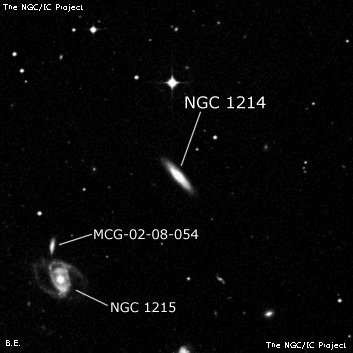
Ormond Stone discovered NGC 1214 = LM 1-94 = Sw. V-49, along with NGC 1215 and 1216, in 1886 using the 26" refractor at the Leander McCormick Observatory. Stone reported, "mag 14.0, 0.7'x0.2', E 60?." He added a note, "48 seconds f[ollowing] G.C. 647 [NGC 1208] same declination, stellar N[ucleus] in cen of vF neb; 1st of 3 [with NGC 1215 and 1216]; *10, P 15? Delta [separation] 3'." His rough position (nearest min of RA) is essentially correct.
Lewis Swift also found this galaxy on 21 Oct 1886. He described it as "F; pS; iR; 647 [=[NGC 1208] nr; 1st of 2 [with NGC 1215]." Frank Muller suggested the equivalence with Stone's object in a Sidereal Messenger article (Feb 1887) that listed nebulae from Swift's 5th catalogue which had been discovered previously. As the Leander McCormick discovery list was submitted to the Astronomical Journal on 12 Oct 1886, the discovery credit goes to Stone.
400/500mm - 17.5" (10/20/90): faint, very small, elongated 2:1 SW-NE, small bright core, stellar nucleus. A mag 11 star is 2.7' N. FIrst of four in the field with NGC 1215 4' SE and NGC 1208 11' W. Brightest in HCG 23.
600/800mm - 24" (12/6/18): at 375x; between fairly faint and moderately bright, fairly high surface brightness edge-on 4:1 SW-NE, 1.1'x0.3', small bright core. In a small group (HCG 23) with NGC 1215 is 4.5' SE and NGC 1216 7' SE.
900/1200mm - 48" (10/30/16): at 375x and 488x; bright, fairly large, very elongated 7:2 SW-NE, ~1.2'x0.35', sharply concentrated with a very bright core that increases to a stellar nucleus. Brightest in the HCG 23 quintet with NGC 1215 4' SE. A mag 11 star is 2.7' due north. The seeing and transparency was subpar during the observation of the group.
Notes by Steve Gottlieb